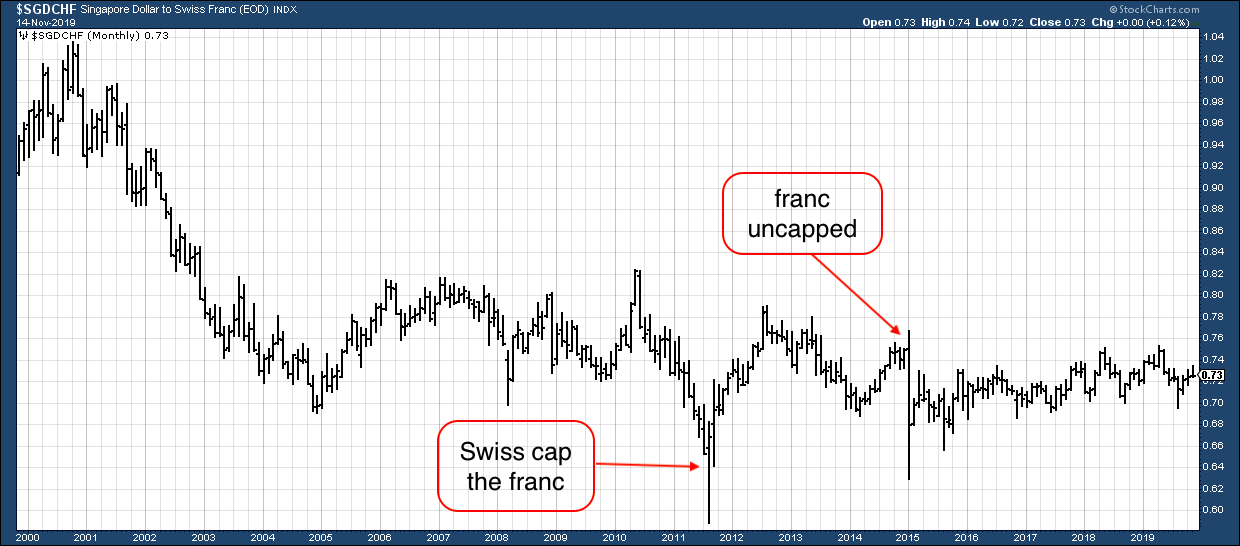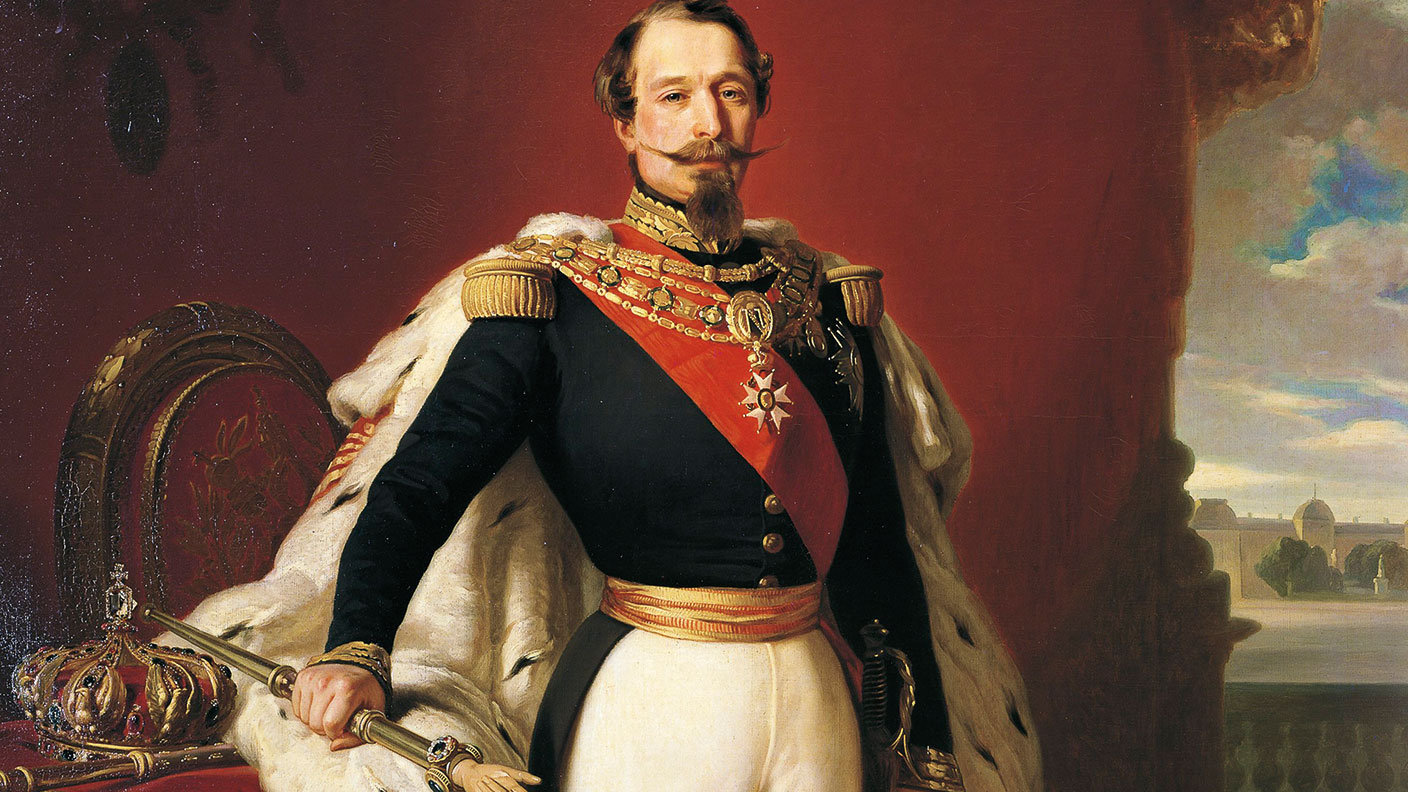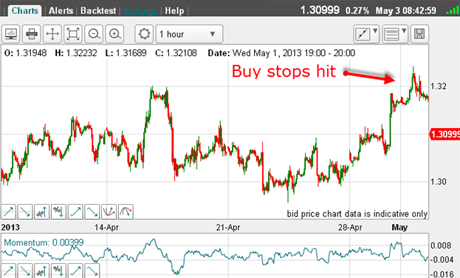Currency Corner: A lesson from two of the world’s “hardest” currencies
Dominic Frisby looks at the Swiss franc and Singaporean dollar and what our politicians can learn from these two fiscally responsible nations.


Last week we wrote about how the euro was setting up for a buy signal against the yen. I thought I should alert you straight away that the buy signal never came.
The market reversed this week, so we never got the moving average cross we were looking for. The downtrend (in the euro) continues.
As we were looking at the currencies of two nations Japan and the EU (perhaps I should say "regions") whose central banks are intent on devaluing their money, I thought this week it might be instructive to compare the currencies of two nations whose fiscal policy has proved rather more sound: Switzerland and Singapore.
MoneyWeek
Subscribe to MoneyWeek today and get your first six magazine issues absolutely FREE

Sign up to Money Morning
Don't miss the latest investment and personal finances news, market analysis, plus money-saving tips with our free twice-daily newsletter
Don't miss the latest investment and personal finances news, market analysis, plus money-saving tips with our free twice-daily newsletter
The currency of Switzerland (and of its neighbouring microstate, Liechtenstein) is the franc. Long considered a safe-haven currency, the Swiss franc was, I believe, the last currency to be gold-backed, only abandoning its gold standard in 2000.
Back then, it was Swiss law that the currency be 40% backed by gold, which is actually, by gold standard terms, quite a high percentage. In the 19th century, for example, the pound was, on average, around 25% backed by gold, research by analyst Thomas Paterson has shown. In times of economic contraction that figure would rise to around 50%, and in times of expansion it was as low as 12.5%.
If you divide the Swiss money supply buy its gold reserves, even today it is around 20% (compared to 3%-4% for the UK).
As money fled to Switzerland during the Greek economic crisis earlier this decade, the Swiss franc appreciated considerably. The Swiss response which took forex markets very much by surprise was to cap the franc against the euro at CHF1.20 to halt its "excessive" advance. The franc immediately lost nearly 10% of its value.
However, the advance resumed, and at one stage in 2014 the Swiss had to resort to negative rates to keep a lid on their currency. In 2015 the Swiss gave up trying to keep a lid on things with another surprise announcement that saw a one-day 30% leap in the franc against the euro.
I remember skiing with three friends in France a couple of weekends later. We agreed that we would take it in turn to buy lunch. One day we crossed the border into Switzerland. My poor friend whose turn it was to buy lunch that day! Fortunately not me.
The evolution of the Singaporean dollar
So to the Singapore dollar. It was pegged to the pound until the early 1970s, when it switched briefly to the dollar before, in 1973, pegging itself to a basket of currencies. This basket was trade-weighted but also went undisclosed. It lasted until 1985 when the dollar became more free-floating, though still closely monitored by the Monetary Authority of Singapore (MAS), to ensure its exports remain competitive. So does it operate today.
Against both the US dollar and the pound, both currencies are a lot higher than they were 20 years ago. You could buy a Swiss franc for about $0.55 back in 2000. Today the US dollar and the Swiss franc trade at parity. A Singapore dollar was $0.53 in 2000 and today it is $0.73.
So how have the Swiss franc and the Singapore dollar fared against each other?
Here's a 20-year chart, which shows how many francs it takes to buy a Singapore dollar. The fewer francs it takes, the stronger the franc. Thus if the chart below is falling, the franc is strengthening and the Singapore dollar is weakening.
I've also highlighted those two big events in 2011 and 2015, which affected the valuation of the Swiss franc. The high for the Swiss franc came in 2011 during the Greek crisis.

You can see how the Swiss franc outperformed the Singapore dollar in the early part of the century, but since around 2003 the two have been in a fairly narrow range. There has been nothing like the extremes seen between other currency pairs.
Since 2015 the range has closed and been even more narrow, between around S$0.68 and S$0.75.
Two nations with relatively sound fiscal policy, and the result is very little volatility in the forex markets.
Those who are pledging such government largesse in the lead-up to this General Election in the UK, take note.
Get the latest financial news, insights and expert analysis from our award-winning MoneyWeek team, to help you understand what really matters when it comes to your finances.
Dominic Frisby (“mercurially witty” – the Spectator) is as far as we know the world’s only financial writer and comedian. He is the author of the popular newsletter the Flying Frisby and is MoneyWeek’s main commentator on gold, commodities, currencies and cryptocurrencies. He has also taken several of his shows to the Edinburgh Festival Fringe.
His books are Daylight Robbery - How Tax Changed our Past and Will Shape our Future; Bitcoin: the Future of Money? and Life After the State - Why We Don't Need Government.
Dominic was educated at St Paul's School, Manchester University and the Webber-Douglas Academy Of Dramatic Art.
You can follow him on X @dominicfrisby
-
 UK sets out crypto regulatory proposals
UK sets out crypto regulatory proposalsThe government has tabled legislation that sets out a regulatory framework for cryptocurrencies, while the regulator will consult on balancing innovation and consumer protections
-
 What does an interest rate cut mean for my pension?
What does an interest rate cut mean for my pension?Interest rates have been cut from 4% to 3.75%. For pension savers and retirees the effects of the drop will depend on the type of retirement pot they have, but could be significant.
-
 What the Latin Monetary Union – Europe’s forgotten currency – can teach us about the euro
What the Latin Monetary Union – Europe’s forgotten currency – can teach us about the euroOpinion The euro isn’t the continent’s first flawed single currency, says Jonathan Compton. The Latin Monetary Union lasted 61 years.
-
 Betting on politics: deal or no deal
Betting on politics: deal or no dealFeatures Matthew Partridge looks at the bookies' odds on the UK leaving the EU with no deal.
-
 Betting on politics: how my tips have fared over the last three years
Betting on politics: how my tips have fared over the last three yearsFeatures It's been three years since Matthew Partridge launched his Betting on Politics column. As you might expect, he's some failures – but he's had a lot more successes
-
 Where did it all go right for the euro?
Where did it all go right for the euro?Sponsored SPONSORED CONTENT - The European currency is alive and kicking. Jake Trask, research director at forex house OFX, explains how the euro became a strong and stable currency, and the outlook for investors.
-
 Record low interest rates – how did the euro react?
Record low interest rates – how did the euro react?Features The euro's reaction to the interest rate decision punished many erring traders - on both sides of the market, says John C Burford. Here, he surveys the fallout, and plots his next trade.
-
Why euro bulls may stay lucky
Features With the eurozone in such a mess, everyone is expecting the single currency to plummet at any moment. But there are still some good reasons to stay long for now, says Tim Bennett.
-
Profit from volatility with forex
Features While markets hate uncertainty, it can also present opportunities. And the extra volatility it has created in the foreign-exchange market recently has created a wealth of possibilities for the short-term trader, says professional investor Jane Foley. Here, she explains how to profit.
-
Europe's debt mountain crushes the euro
Features With Greece and Spain having their credit ratings downgraded, and Portugal and Ireland under scrutiny, the euro has been pushed down against he dollar and is set to sufffer further.
